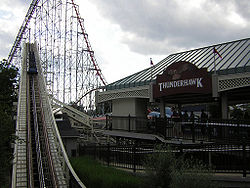This article needs additional citations for verification .(July 2014) |
| Thunderhawk | |
|---|---|
| Previously known as "The Coaster" | |
 Thunderhawk's lift hill and station at Dorney Park & Wildwater Kingdom | |
| Dorney Park & Wildwater Kingdom | |
| Location | Dorney Park & Wildwater Kingdom |
| Coordinates | 40°34′47″N75°32′08″W / 40.5798°N 75.5355°W |
| Status | Operating |
| Opening date | March 30, 1924 |
| General statistics | |
| Type | Wood |
| Manufacturer | Philadelphia Toboggan Coasters |
| Designer | Herbert Paul Schmeck |
| Track layout | Out and Back / Twister |
| Lift/launch system | Chain lift hill |
| Height | 80 ft (24 m) |
| Drop | 65 ft (20 m) |
| Length | 2,767 ft (843 m) |
| Speed | 45 mph (72 km/h) |
| Inversions | 0 |
| Duration | 1:18 |
| Max vertical angle | 45° |
| Height restriction | 48 in (122 cm) |
| Trains | 2 trains with 4 cars. Riders are arranged 2 across in 3 rows for a total of 24 riders per train. |
| Thunderhawk at RCDB | |
Thunderhawk is a wooden roller coaster with an out-and-back layout located at Dorney Park & Wildwater Kingdom in Allentown, Pennsylvania. Originally opening as The Coaster in 1924, Thunderhawk is the oldest operating roller coaster in the Cedar Fair chain, and one of the oldest in the world still in operation. It was manufactured by Philadelphia Toboggan Coasters (PTC) and designed by Herbert Paul Schmeck.